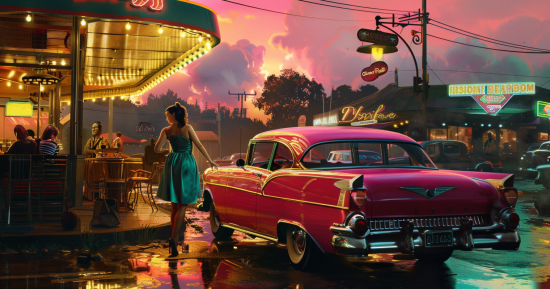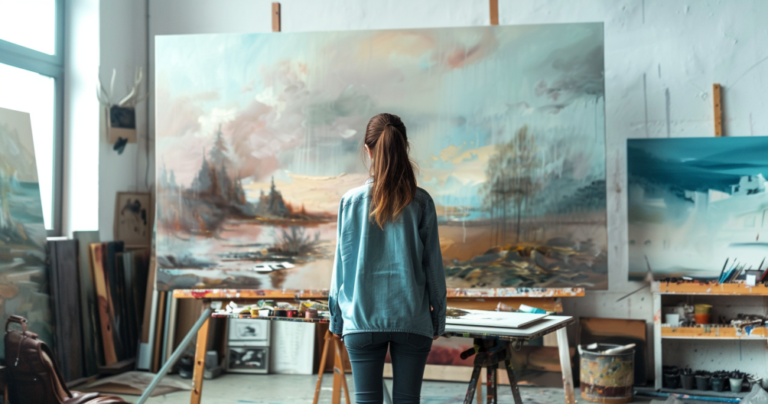Pop art is bold, playful, and all about turning the ordinary into something extraordinary. Rooted in the 1950s and 60s, this artistic movement celebrates everyday culture, from soup cans and comic books to celebrities and ads. Whether you’re new to art or want to try something new, this guide will show you how to make pop art with simple tools and tons of creativity.
What Is Pop Art?
Pop art is short for “popular art.” It emerged in post-war America and Britain and was inspired by mass media, consumerism, and pop culture. Artists like Andy Warhol, Roy Lichtenstein, and Jasper Johns brought everyday items, like soup cans, flags, or comic panels, into the fine art world.
Pop art features:
- Bright, contrasting colors
- Bold outlines and flat imagery
- Repeated patterns or images
- Commercial or celebrity themes
- Humor and irony
The message? Art can be fun, accessible, and inspired by what we see around us every day.
In your pop art journey, experiment with different materials and themes, such as consumption and materialism. Feel free to indulge your creativity and play with vibrant colors and bold patterns. Don’t be afraid to take inspiration from everyday items and turn them into something extraordinary. Remember, the key to successful pop art is to enjoy the process and let your imagination soar!
Materials You’ll Need

Traditional Supplies
- Acrylic paint (bright, high-contrast colors)
- Thick paper, canvas, or wood panels
- Paintbrushes (various sizes)
- Black markers or pens for outlining
- Scissors or craft knives
- Glue, stencils, or collage materials
Digital Tools
- Photoshop, Illustrator, or apps like Picsart, BeFunky, and Prisma
- Stylus or drawing tablet (optional)
- Access to photo filters or pop art effects
Whether you’re going analog or digital, pop art is about simplicity and strong visuals, so don’t worry about being a professional. Just get started!
How to make Pop Art Step-by-Step per Hand

1. Pick Your Subject
Choose something simple and recognizable:
- A soda can
- Sunglasses
- Your pet or selfie
- A popular snack or object
- A favorite celebrity
2. Sketch or Upload the Image
Draw a quick outline on paper or import a photo into your digital program. Focus on clear shapes and bold lines.
3. Add Bold Colors
Use bright reds, blues, yellows, and contrasting combos. Fill in spaces with flat color blocks, just like comics.
4. Add Details
Include:
- Halftone dots (comic book effect)
- Thick black outlines
- Speech bubbles or bold words like “BAM!” or “WOW!”
- Patterns like polka dots or stripes
5. Finish and Display
Review your piece, add final touches, and sign it! Whether you hang it on a wall or post it online, celebrate your unique style.

Color and Typography Tips
Mastering Pop Art Colors
- Stick to primary colors: red, blue, yellow. These form the bold foundation of many pop art pieces.
- Use complementary colors to create contrast (like blue/orange, red/green).
- Choose flat, saturated tones, pop art rarely uses gradients or subtle transitions.
- Limit your palette: using too many colors can overwhelm the composition. Pick 3-5 bold shades.
- Add white or black to increase contrast and make key elements pop.
Text Elements
- Use block-style fonts, bubble letters, or comic sans-inspired typography.
- Add bold outlines or drop shadows to your letters for more impact.
- Use all caps and short, punchy words like “WOW,” “BOOM,” or “YUM.”
- Place text in banners, speech bubbles, or color blocks.
- Stick with 1 or 2 font styles per artwork to keep it clean and readable.
Traditional Techniques to Try
Collage
- Use magazines, product packaging, newspapers, or photos to build your design.
- Mix textures, combine glossy magazine cutouts with matte painted elements.
- Rearrange familiar items into something unexpected or funny.
Stenciling
- Create your own stencils with cardboard or plastic sheets.
- Spray or dab paint through the stencil to build patterns or shapes.
- Layer multiple stencils to make complex compositions.
Silkscreen Printing
- Use mesh screens and ink to print repeated images with different color combinations.
- Great for creating series of the same subject (like Warhol’s Marilyn Monroe prints).
Painting
- Use acrylics for bold colors and quick drying.
- Paint flat areas of color and outline them with black marker or paint.
- Try comic-style shading using dots (Ben-Day dots), crosshatching, or stripes.
- Add highlight areas with white paint to create light reflection effects.
Traditional techniques are hands-on, tactile, and perfect for classrooms, art parties, or home projects.
Digital Pop Art Techniques
- Use filters that mimic halftone or comic effects
- Layer images and text digitally
- Add gradients, neon glow, or sticker-style effects
- Duplicate and recolor images for that classic pop repetition
Digital pop art is perfect for social media, custom stickers, or printable posters.
Pop Art Project Ideas
- A custom pop art portrait of a friend or pet
- Your favorite snack turned into a poster
- A vintage comic book cover with your own character
- A pop-art-inspired T-shirt or mug design
- A series of repeated selfies in different colors (à la Warhol)
Why Try Pop Art?
- It’s beginner-friendly
- It turns everyday life into bold expression
- You can work with what you have—no fancy tools needed
- It’s great for kids, teens, and adults
Whether for school, fun, or personal expression, pop art is a powerful way to be creative and playful at the same time.

What objects are popular in pop art?
Consumer goods, comic strips, celebrities, snacks, logos, and household items like soup cans or soda bottles.
Can I make pop art with just my phone?
Artists like Richard Hamilton and Eduardo Paolozzi in Britain, and Andy Warhol and Roy Lichtenstein in the U.S.
Do I need to know how to draw?
Not at all. Many pop art styles rely on photos, stencils, or collage techniques that are perfect for beginners.







[…] Want to create your own style of Pop-Art? Right this way to How to Make Pop Art: A Simple Guide for Beginners 2025 […]